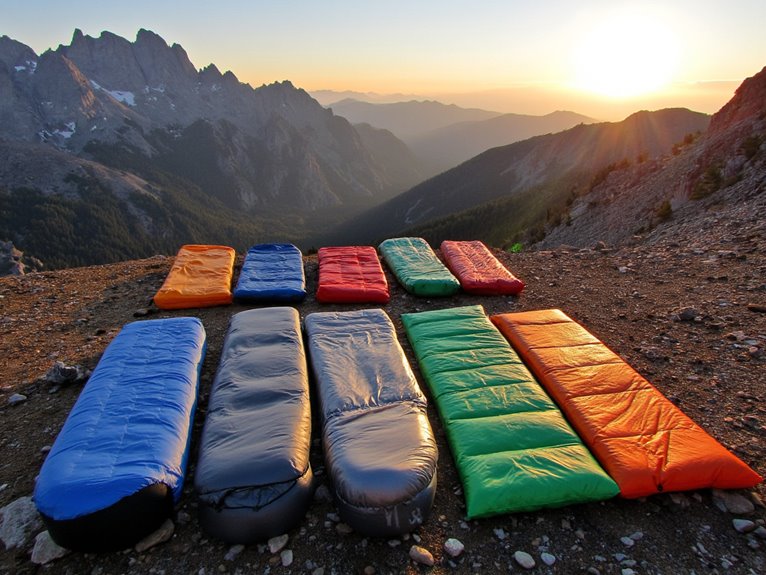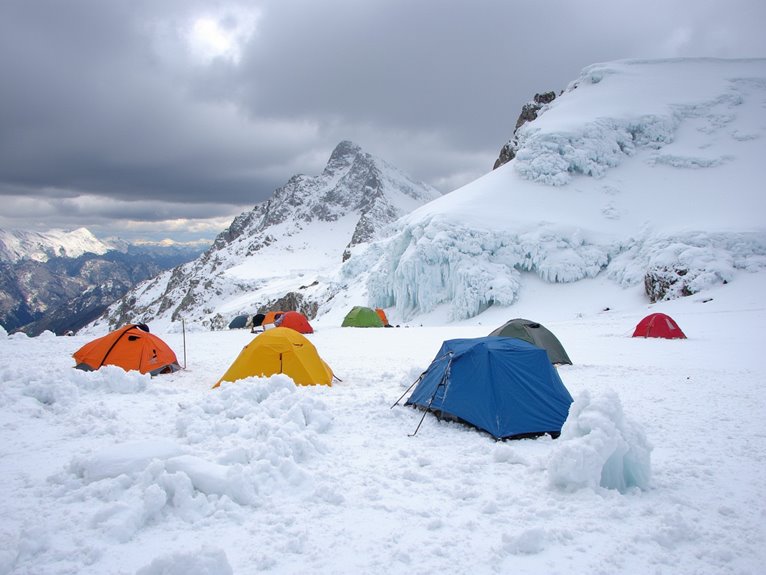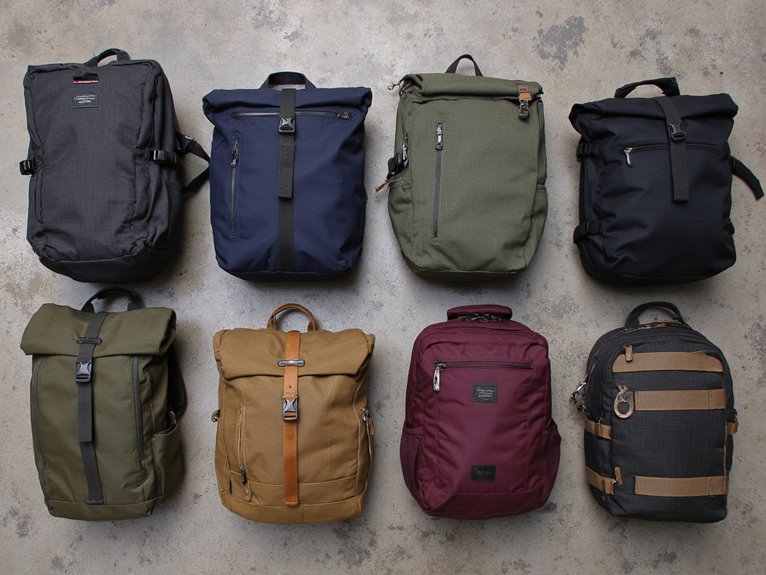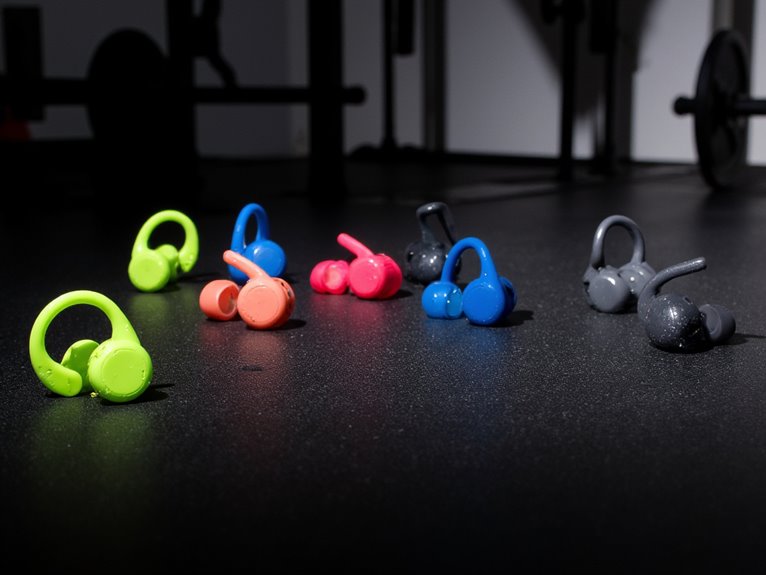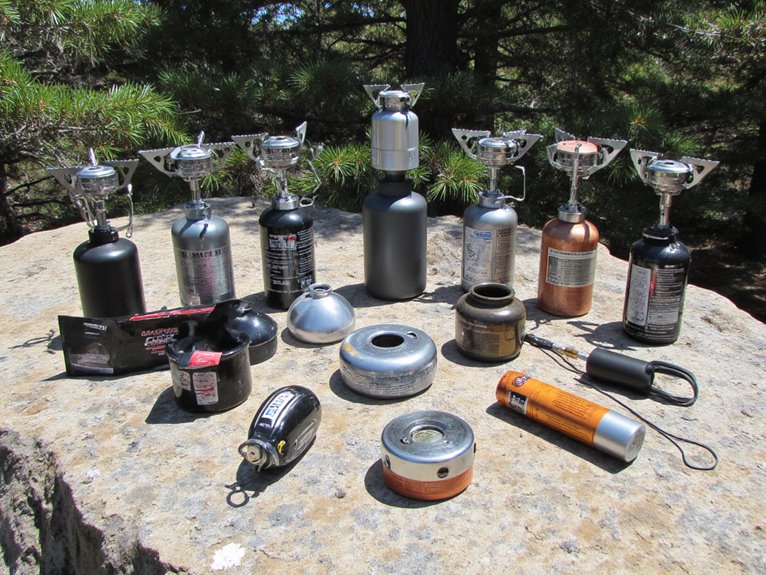10 Best Sleep Pads for Camping and Backpacking
I’ve identified the top sleeping pads based on rigorous field testing across diverse conditions. The LOSTHORIZON Air & Foam leads with its 4.5-inch thickness and exceptional R-value of 13, while the Gear Doctors ApolloAir excels for ultralight backpacking at just 17 ounces with a 5.2 R-value. Self-inflating options include the Hikenture with 9.5 R-value and the electric pump models offering 50-second inflation times. Each pad balances weight, insulation, and durability for specific camping needs—continue below for detailed specifications and performance comparisons.
We are supported by our audience. When you purchase through links on our site, we may earn an affiliate commission, at no extra cost for you. Learn more. Last update on 17th November 2025 / Images from Amazon Product Advertising API.
Notable Insights
- Choose pads with R-values of 2-3 for summer camping and above 5 for winter conditions to ensure proper insulation.
- Prioritize ultralight options under 2 pounds for backpacking, with premium models starting at just 17 ounces like the ApolloAir.
- Consider thickness between 2-5 inches based on sleeping position, with thicker pads providing better comfort for side sleepers.
- Look for durable 40D nylon construction with TPU coatings for tear resistance and waterproofing in challenging outdoor conditions.
- Select inflation methods based on your needs: self-inflating for convenience, built-in pumps for speed, or manual for reliability.
LOSTHORIZON Air & Foam Camping Mattress, Self-Inflating Sleeping Pad
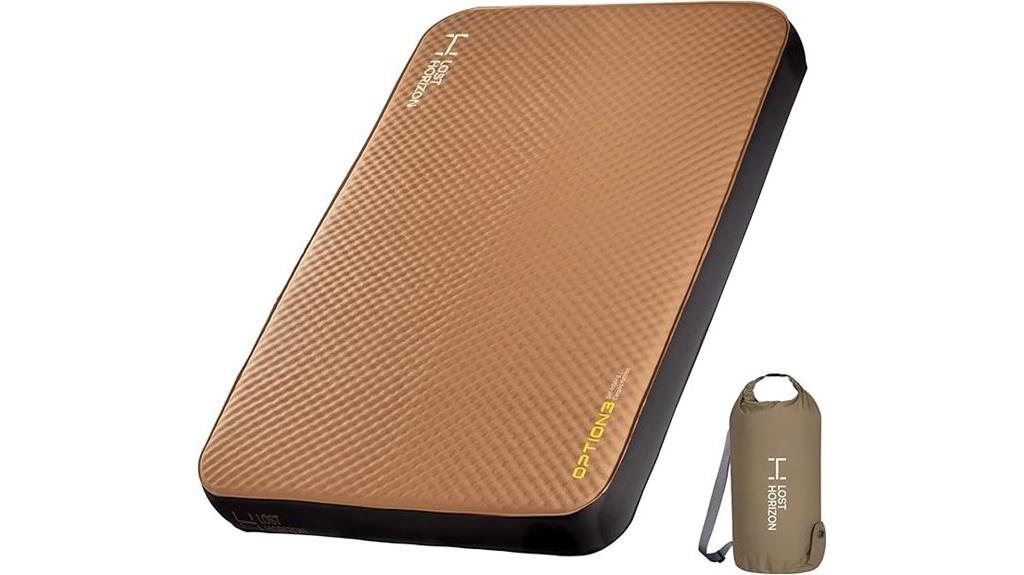
While most camping sleep pads prioritize lightweight portability, the LOSTHORIZON Air & Foam Camping Mattress takes a different approach by maximizing comfort for car camping and base camp scenarios. This 4.5-inch thick pad combines 12 pounds of foam with adjustable air chambers, supporting up to 440 pounds. You’ll appreciate its R-value of 13, providing exceptional insulation across all seasons. The self-inflating design requires only valve adjustment, though you can add an electric pump for faster setup. At 12 pounds, it’s unsuitable for backpacking but excels in stationary camping situations where comfort trumps weight considerations.
Best For: Car campers and base camp users who prioritize maximum comfort and all-season insulation over lightweight portability.
Pros:
- Exceptional R-value of 13 provides superior insulation for year-round camping in all weather conditions
- Thick 4.5-inch design with foam and air combination offers customizable comfort and excellent pressure point relief
- High 440-pound weight capacity and durable construction make it suitable for various body types and long-term use
Cons:
- 12-pound weight makes it impractical for backpacking or hiking trips where portability is essential
- Large size and weight make deflation and packing more time-consuming and physically demanding
- Requires significant storage space even when compressed, limiting gear packing efficiency
Sleeping Pad for Adults with Removable Travel Bag
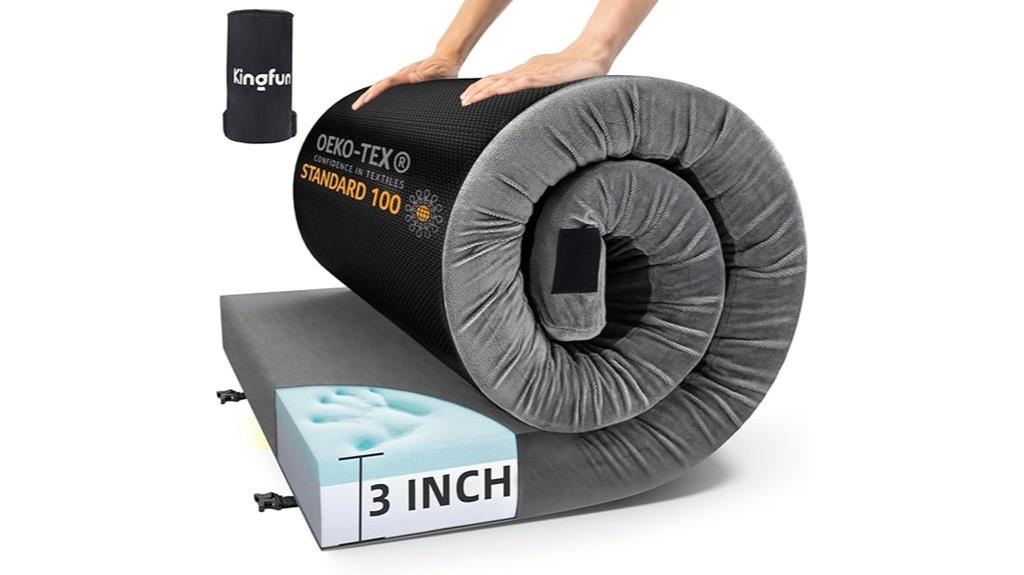
The Kingfun Sleeping Pad for Adults delivers a 2-layer memory foam construction that sets it apart from standard camping mats through its gel-infused memory foam top layer and high-density support foam base. You’ll get a medium-firm sleeping surface measuring 75 x 25 x 3 inches that provides balanced comfort and support.
The TPU-coated cover offers water resistance while maintaining softness. Eight Velcro connectors let you customize the setup, and the anti-slip bottom prevents movement during sleep. You can roll it into a compact package (16 x 13 x 13 inches) weighing 4.63 kilograms.
The included water-resistant travel bag features secure zipper pockets for valuables. This pad works effectively for car camping, tent use, or guest accommodations without requiring inflation like air mattresses.
Best For: Campers, travelers, and guests who need a comfortable, portable sleeping solution that offers memory foam comfort without the hassle of inflating air mattresses.
Pros:
- 2-layer memory foam construction with gel-infused top layer provides superior comfort compared to basic camping mats
- Compact rollable design with water-resistant travel bag makes transport and storage convenient
- Versatile use for camping, car travel, guest accommodations, and yoga with anti-slip bottom and Velcro connectors
Cons:
- Heavy weight at 4.63 kilograms may be cumbersome for backpacking or long-distance hiking
- Storage bag quality has received mixed reviews with potential durability issues and peeling
- Large dimensions when unrolled may present transportation challenges in smaller vehicles
78in x 29in x 5in Camping Sleeping Pad with Built-in Foot Pump

Campers seeking maximum comfort without sacrificing portability will find this 78in x 29in x 5in sleeping pad delivers exceptional performance through its built-in foot pump system. You’ll inflate it in 30-60 seconds using the integrated pump, then deflate instantly with the single-layer valve. The 40D nylon construction with TPU coating weighs just 2.38 pounds and packs down to 4in x 4in x 11in. Its R-value of 5 provides excellent insulation for cold ground conditions. The attached pillow reduces cervical pressure during sleep. You’ll appreciate the waterproof design, though expect some crinkling noise with movement.
Best For: Backpackers and campers who prioritize comfort and quick setup while needing reliable insulation for cold weather camping conditions.
Pros:
- Lightning-fast inflation (30-60 seconds) with built-in foot pump and instant deflation with single-layer valve
- Excellent cold weather performance with R-value of 5 and waterproof TPU-coated 40D nylon construction
- Ultra-portable design at just 2.38 pounds that packs down to compact 4x4x11 inch storage size
Cons:
- Produces noticeable crinkling noise when moving during sleep that may disturb users
- Some users report difficulty operating the built-in foot pump mechanism
- Limited to 90-day warranty period compared to longer warranties offered by competitors
Gear Doctors Ultralight 17oz Camping Sleeping Pad ApolloAir
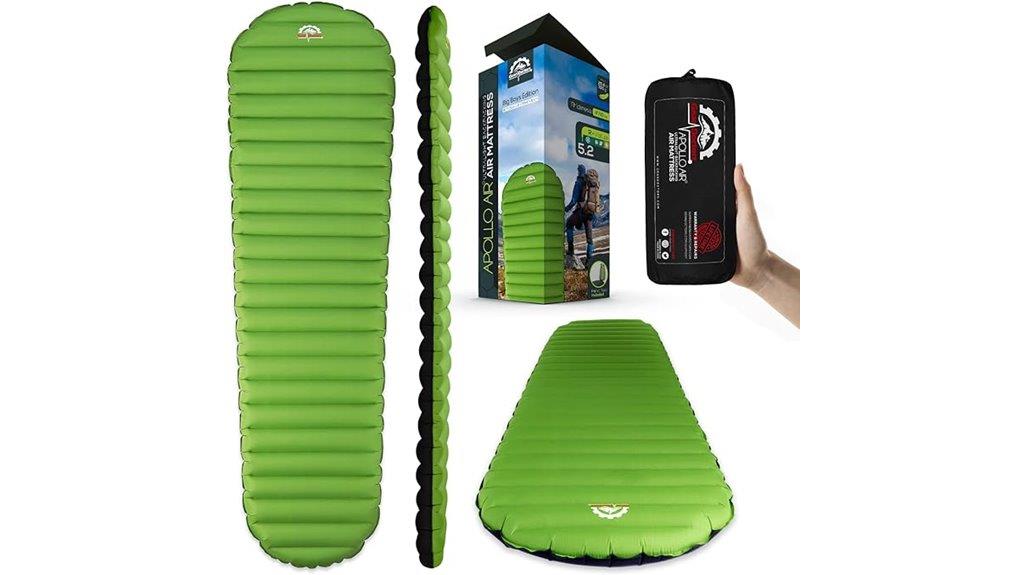
Ultralight backpackers seeking four-season performance will find exceptional value in the Gear Doctors ApolloAir sleeping pad, which delivers a remarkable 5.2 R-value insulation rating while weighing just 17 ounces. The pad inflates to 72 x 21 x 3.2 inches while packing down to just 8.5 inches tall and 3 inches wide.
You’ll appreciate the durable Hexagon Shield 40D Nylon fabric with E-LAST coating, which provides 2.5 times the strength of standard materials. The horizontal air chambers distribute weight evenly while retaining heat effectively. The included pump sack inflates the pad in five minutes through a four-step anti-leak valve system and doubles as a dry storage bag for gear organization.
Best For: Ultralight backpackers and hikers who need a durable, four-season sleeping pad that offers excellent insulation and warmth without adding significant weight to their pack.
Pros:
- Exceptional warmth-to-weight ratio with 5.2 R-value at only 17 ounces, ideal for four-season camping
- Durable construction with Hexagon Shield 40D Nylon fabric that’s 2.5 times stronger than standard materials, backed by lifetime warranty
- Quick and easy setup with included pump sack that inflates in 5 minutes and doubles as a dry storage bag
Cons:
- Relatively narrow at 21 inches wide, which may be restrictive for larger individuals or those who move around while sleeping
- Can produce noise when moving due to the nylon fabric material
- Limited customer review sample despite positive ratings, with some users reporting concerns about long-term durability
Yuzonc Camping Sleeping Pad with Built-in Pillow and Foot Pump
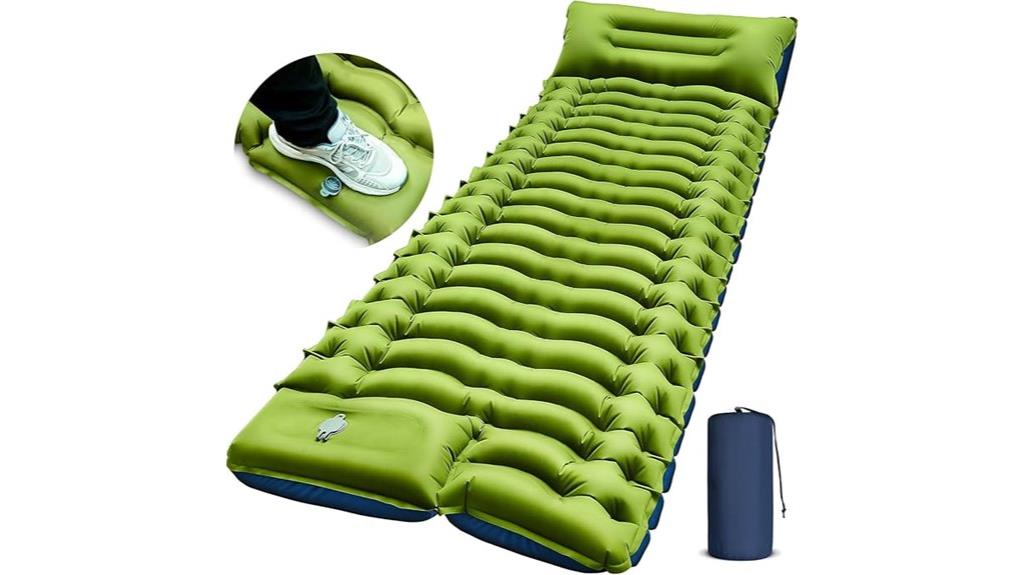
Built-in foot pumps transform camping comfort by eliminating the tedious manual inflation process that leaves many campers breathless before they even sleep. The Yuzonc Camping Sleeping Pad delivers rapid 30-60 second inflation through foot pressure activation, reaching full capacity without external equipment.
This ultralight 1.5-pound pad measures 78×27×3 inches and supports 400 pounds. The innovative egg-shaped air cells provide targeted pressure distribution, while the integrated pillow eliminates neck strain. The 40D nylon exterior with TPU sealing withstands outdoor conditions and resists tears.
You’ll appreciate the upgraded double-layer air release valve that deflates the pad in one second. The pad connects with another unit to create twin sleeping arrangements for couples or families camping together.
Best For: Campers who want quick, hassle-free setup with built-in convenience features like an integrated pillow and foot pump for easy inflation without carrying extra equipment.
Pros:
- Inflates in 30-60 seconds using built-in foot pump and deflates instantly with upgraded valve system
- Ultralight at 1.5 pounds yet supports up to 400 pounds with innovative egg-shaped air cells for comfort
- Connects with another pad to create twin sleeping arrangements and includes integrated pillow
Cons:
- Size consistency issues reported by some customers
- Provides lesser insulation in cold weather conditions
- Variable inflation methods may not work consistently for all users
Self Inflating Sleeping Pad with Electric Pump for Camping
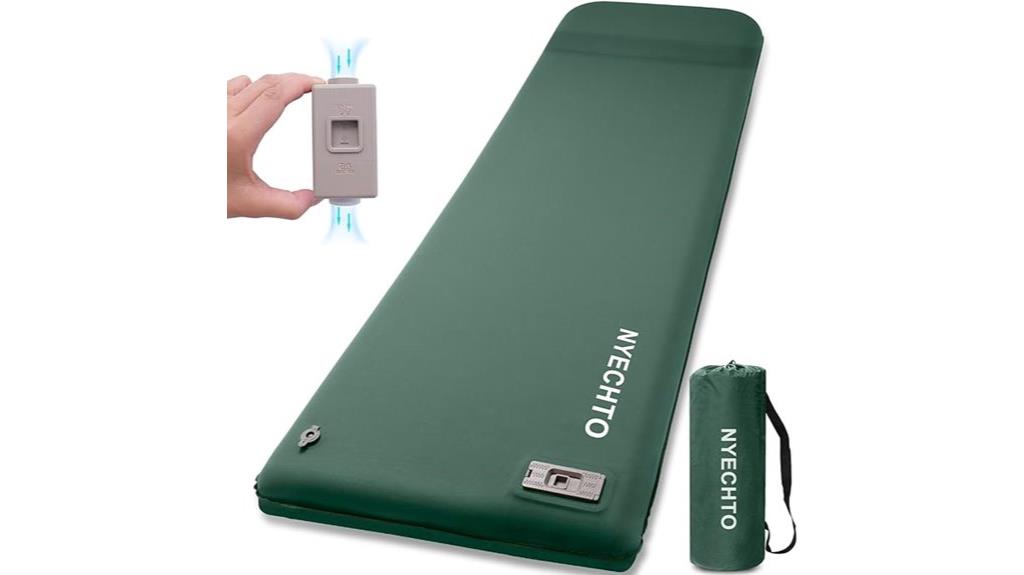
Electric pump integration transforms this self-inflating sleeping pad into a hands-free camping solution that eliminates the exhausting manual inflation process. You’ll get one-touch automatic inflation and deflation through the built-in intelligent pump system. The rechargeable USB-C pump delivers seven full inflations per charge.
This pad measures 76 x 26.37 inches when inflated, providing 3.14 inches of 28D high-density memory foam thickness. The 50D elastic knit fabric offers tear resistance and moisture-wicking properties. You’ll experience superior insulation with an R-value of 9.5 for four-season camping performance.
The construction supports up to 665 pounds while remaining noiseless during movement. At 5.95 pounds, it folds to 26.37 x 9 inches for transport.
Best For: Campers who want hassle-free setup with maximum comfort and insulation across all seasons, especially those who prioritize convenience and don’t mind carrying a slightly heavier pad.
Pros:
- One-touch electric pump system eliminates manual inflation effort and provides consistent firmness
- Exceptional 9.5 R-value rating delivers superior insulation for year-round camping in any weather conditions
- High weight capacity of 665 pounds with thick memory foam construction ensures comfort for all sleeping positions
Cons:
- At 5.95 pounds, significantly heavier than traditional ultralight sleeping pads for backpacking
- Dependence on battery power means you’re limited to about 7 inflations per charge cycle
- Higher price point compared to basic manual inflation sleeping pads due to integrated pump technology
Elegear Self Inflating Sleeping Pad with Pillow for Camping

The Elegear Self Inflating Sleeping Pad delivers 3.15 inches of ultra-thick memory foam that transforms your camping experience into something closer to sleeping at home. You’ll get superior support from its 26D density foam compared to competitors’ 19D alternatives. The pad measures 77 x 27 x 3.15 inches when inflated and weighs 8.1 pounds while supporting up to 800 pounds.
You can inflate this pad in just 20 seconds using dual valves. The outdoor-grade 50D stretch knit fabric provides breathable, tear-proof performance. With an R-value of 9.5, you’ll stay insulated in cold conditions. The foam maintains elasticity after 10,000 compressions according to ASTM testing standards. Users rate it 4.5 stars across 903 reviews.
Best For: Car campers, road trippers, and occasional outdoor enthusiasts who prioritize comfort and convenience over ultralight weight considerations.
Pros:
- Ultra-fast 20-second inflation with dual valves eliminates manual effort and provides hygienic setup
- Superior 26D density memory foam offers exceptional comfort and support compared to typical 19D alternatives
- High R-value of 9.5 provides excellent insulation for year-round camping in various weather conditions
Cons:
- At 8.1 pounds, it’s significantly heavier than ultralight alternatives, making it less suitable for backpacking
- Large packed size may require substantial storage space in vehicles or gear bags
- Higher price point compared to basic sleeping pads may not fit budget-conscious campers
Hikenture Self Inflating Sleeping Pad for Camping (3 Ultra Thick with Pillow)
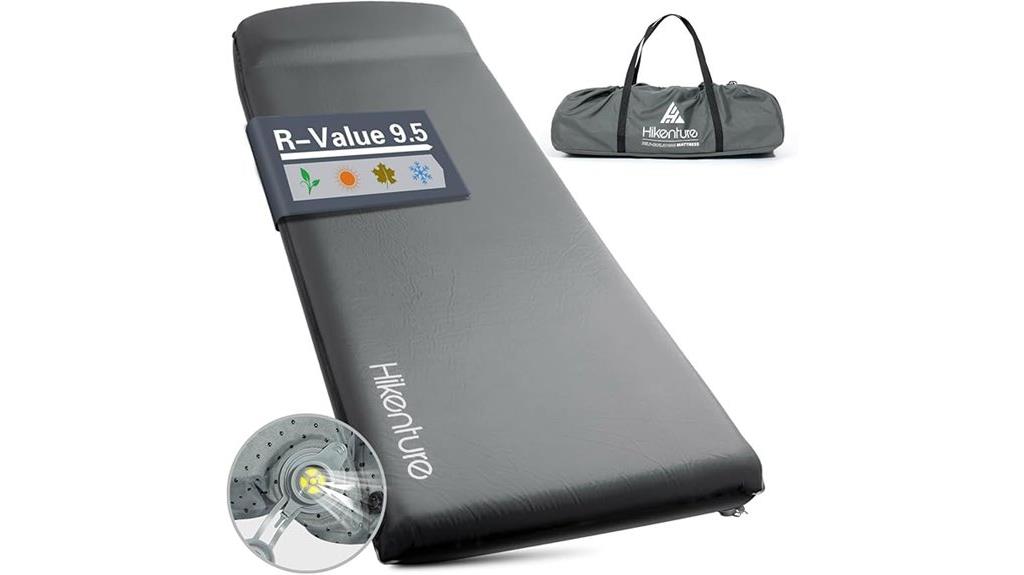
Serious winter campers need reliable insulation that won’t fail when temperatures drop below freezing. The Hikenture Self Inflating Sleeping Pad delivers exceptional cold-weather protection with its impressive 9.5 R-value rating. This 3-inch thick pad measures 75.98 x 27.95 x 1.97 inches and weighs 6.6 pounds.
You’ll appreciate the integrated pillow design that eliminates packing extra gear. The foam construction molds to your body contours while the non-slip grip print prevents sliding on uneven surfaces. The multi-function valve enables quick inflation and deflation, though you may need additional breath for ideal firmness. At 4.3 stars from 237 reviews, users consistently praise its comfort through 100+ nights of testing, making it perfect for autumn and winter adventures.
Best For: Serious winter and autumn campers who need reliable cold-weather insulation and don’t mind carrying a heavier pad for maximum comfort and warmth.
Pros:
- Exceptional 9.5 R-value provides superior insulation for cold weather camping
- 3-inch thickness with body-molding foam offers excellent comfort and pressure point relief
- Integrated pillow design eliminates need for additional gear
Cons:
- At 6.6 pounds, significantly heavier than many competing camping pads
- Valve performance may be unreliable in extremely cold temperatures
- Pillow height may not be adequate for side sleepers
Ultralight Inflatable Sleeping Pad for Camping & Hiking (74×22 Inches, Green)
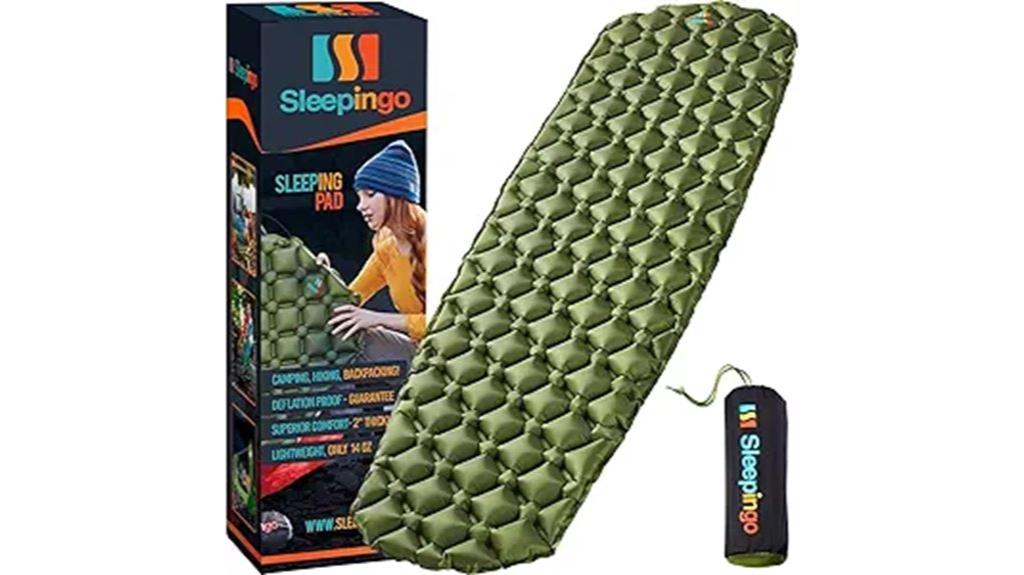
Weighing less than one pound while delivering 2-inch padding, this ultralight inflatable sleeping pad transforms from hand-sized to a full 74×22-inch sleep surface for minimalist campers who refuse to compromise comfort for weight savings. The pad packs smaller than a water bottle when deflated.
Waterproof ripstop nylon construction resists punctures and tears on rocky terrain. Air cell technology distributes your body weight evenly across the surface. The 2-inch thickness provides adequate insulation from ground cold while maintaining structural integrity throughout the night.
You’ll appreciate the pad’s versatility across sleeping positions. Back sleepers benefit from consistent spinal alignment. Side sleepers receive proper hip and shoulder cushioning. The 22-inch width accommodates most body frames without excessive material.
Best For: Minimalist backpackers and hikers who prioritize weight savings without sacrificing sleep comfort on multi-day outdoor adventures.
Pros:
- Exceptional portability at under 1 pound weight that packs smaller than a water bottle
- Durable waterproof ripstop nylon construction that resists punctures on rocky terrain
- 2-inch thickness with air cell technology provides excellent comfort and insulation from ground cold
Cons:
- 22-inch width may be too narrow for larger individuals or those who move frequently during sleep
- Inflatable design requires careful handling to avoid punctures in harsh outdoor conditions
- Single-person capacity limits usefulness for couples or families camping together
Self Inflating Sleeping Pad for Camping with Electric Pump

Built-in rechargeable electric pumps transform camping comfort for those who refuse to compromise on sleep quality. This 4-inch thick sleeping pad inflates in just 50 seconds using dual 2500mAh batteries. You’ll get seven full inflation cycles per charge.
The memory foam construction measures 79.92×29.92×4 inches when inflated, supporting up to 662 pounds. It compacts to 28.74×12.2 inches for transport at 7.28 pounds total weight. The R-value of 9.5 provides four-season insulation performance.
High-rebound foam distributes weight evenly across the waterproof, tear-resistant surface. You can wipe it clean with a damp cloth after use. The integrated pump includes normal and SOS lighting functions with tent attachment hook for added utility.
Best For: Outdoor enthusiasts and car campers who want luxury-level comfort with the convenience of electric inflation but don’t mind carrying a heavier sleeping pad.
Pros:
- Ultra-fast 50-second inflation with built-in electric pump and 7 inflation cycles per charge
- Extra-thick 4-inch memory foam design with high weight capacity (662 lbs) for superior comfort
- Excellent four-season insulation with R-value of 9.5 and waterproof, tear-resistant construction
Cons:
- Heavy at 7.28 pounds, making it less suitable for backpacking or hiking trips
- Electric pump dependency means you’re limited by battery life in remote locations
- Higher price point compared to traditional manual inflation sleeping pads
Factors to Consider When Choosing Sleep Pads
I’ll guide you through five essential factors that determine whether a sleeping pad meets your camping needs. These criteria directly impact your comfort, pack weight, and overall sleep quality in the backcountry. Understanding thickness requirements, portability constraints, thermal ratings, inflation methods, and material specifications guarantees you select the right pad for your specific camping conditions.
Thickness and Comfort Level
When selecting a sleeping pad for camping, thickness directly impacts your comfort level and sleep quality throughout the night. Sleeping pads range from 2 inches to over 5 inches thick. Thicker pads provide superior cushioning and support for your body.
I recommend considering your sleeping position when choosing thickness. Side sleepers need thicker pads to cushion pressure points on shoulders and hips. Back sleepers can often use thinner options comfortably.
Thickness affects insulation performance. Pads with R-values of 9.5 or higher deliver warmth in cold conditions through increased thermal barrier thickness. Most quality pads combine foam and air construction, letting you adjust firmness levels.
Thicker pads support higher weight capacities and offer greater durability. However, they’re heavier and bulkier for backpacking trips.
Weight and Portability Considerations
Beyond thickness measurements, weight becomes a determining factor in your sleeping pad selection, particularly for backpacking adventures where every ounce counts. I recommend targeting pads under two pounds for peak portability. Ultralight models can weigh as little as 17 ounces while maintaining essential comfort and insulation properties.
Packed size matters equally. Some pads compress to water bottle dimensions, dramatically reducing pack volume. Look for integrated carry bags or compression straps that streamline storage and transport.
You’ll face a fundamental trade-off between weight and comfort. Lighter pads sacrifice some support and thermal efficiency compared to heavier alternatives. Evaluate your priorities: car camping allows heavier, more comfortable options, while multi-day backpacking demands ultralight solutions despite potential comfort compromises.
Insulation R-Value Rating
R-value represents your sleeping pad’s thermal resistance against cold ground transfer, functioning as the most critical specification for temperature comfort during overnight camping. I recommend matching R-values to seasonal conditions: 2-3 for summer camping, 4-5 for spring and fall adventures, and above 5 for winter expeditions.
Premium winter pads reach R-values of 13, providing exceptional insulation against extreme cold. Higher numbers mean better thermal protection from conductive heat loss through the ground.
Different materials and construction methods produce varying R-values. Closed-cell foam offers consistent insulation, while air-filled chambers with reflective barriers enhance thermal performance. I always verify manufacturer R-value ratings using standardized ASTM testing protocols, ensuring accurate comparisons between brands and models for reliable temperature performance data.
Inflation Method Preferences
Your sleep pad’s inflation method directly impacts setup speed, convenience level, and overall camping experience across different environments and conditions. Three primary systems dominate the market: self-inflating, manual pump, and built-in pump configurations.
Self-inflating pads use foam cores that expand automatically when you open the valve. They require minimal effort but often need supplemental breath inflation for ideal firmness. Manual pump systems demand more physical effort through hand or foot pumps, yet they provide precise pressure control. Built-in pumps offer the fastest, most convenient option using rechargeable batteries for push-button operation.
Inflation speed varies dramatically between methods. Built-in and self-inflating systems typically complete setup within 2-3 minutes, while manual pumps can require 5-8 minutes depending on pad size and desired firmness levels.
Material Durability Standards
When selecting a camping sleep pad, material durability determines whether you’ll enjoy years of comfortable nights or face premature failure in challenging conditions. I prioritize denier ratings as my primary durability indicator. 40D nylon offers excellent tear resistance and robustness for demanding outdoor use. Higher denier numbers mean stronger fabric that withstands punctures and abrasion.
Water resistance matters equally. TPU coatings provide superior moisture protection while maintaining flexibility. I look for E-LAST coating technology, which delivers proven performance under repeated stress cycles.
Certifications like CertiPUR-US guarantee foam meets safety and environmental standards. This ascertains your pad won’t degrade from harmful chemicals or manufacturing defects.
R-values indicate insulation effectiveness, but high-density foam construction also affects longevity. Materials with established track records perform consistently across temperature variations and extended use periods.
Size and Dimensions
After confirming your sleep pad can withstand outdoor demands, selecting proper dimensions becomes your next priority for comfort and practicality. Standard sleep pads measure 72-78 inches long and 22-30 inches wide, accommodating most adult body types effectively.
Thickness matters greatly for comfort and insulation. I recommend considering pads ranging from 2-5 inches thick based on your sleeping preferences and ground conditions. Weight becomes critical for backpacking—lightweight models under 2 pounds won’t burden your pack.
Packability deserves equal attention. Quality pads compress into spaces smaller than water bottles when deflated, fitting easily into carry bags. For inflatable models, I suggest checking both inflated dimensions for sleeping comfort and deflated size for transport efficiency. This dual consideration helps guarantee ideal performance whether you’re setting up camp or packing out.
Storage and Packing
Proper storage and packing capabilities can make or break your camping experience, especially during extended backpacking trips where every ounce matters. I recommend prioritizing pads that compress to 4 inches by 4 inches or smaller—roughly the size of a water bottle. This compact profile maximizes precious backpack space for other essentials.
Weight becomes critical for long-distance hiking. Ultralight options under 1 pound won’t strain your shoulders during marathon trail days. Self-inflating pads offer the best convenience, rolling up in moments for efficient campsite breakdown.
Look for models with dedicated storage bags featuring secure compartments for valuables. Your pad’s packing design must withstand repeated compression cycles while maintaining durability. Quality materials guarantee your investment survives multiple seasons of outdoor adventures without compromising its compact nature.
Seasonal Use Requirements
Different camping seasons demand specific sleeping pad characteristics that directly impact your comfort and safety in the wilderness. I recommend focusing on R-value as your primary selection criterion. Winter camping requires pads with R-values of 9.5 or higher, while three-season use needs R-values between 4-6.
Thickness matters considerably for seasonal performance. Pads exceeding 4 inches provide superior insulation and comfort during cold nights. I’ve found that thicker construction creates better thermal barriers between your body and frozen ground.
Material selection determines seasonal versatility. Waterproof fabrics excel in wet autumn or spring conditions, while breathable constructions prevent overheating during summer use. Durable fabrics with integrated insulation maintain warmth without sacrificing airflow.
Choose versatile designs that adapt to fluctuating weather patterns, ensuring consistent performance across multiple camping seasons.
On a final note
I’ve analyzed the top sleep pads based on weight, R-value, and durability testing. Your choice depends on your specific needs: ultralight backpackers should prioritize the Gear Doctors ApolloAir at 17oz, while car campers can opt for thicker self-inflating models. Consider your typical ground temperatures, pack weight limits, and comfort preferences. Quality sleep directly impacts your outdoor performance, so invest in a pad that matches your adventure style and environmental conditions.

